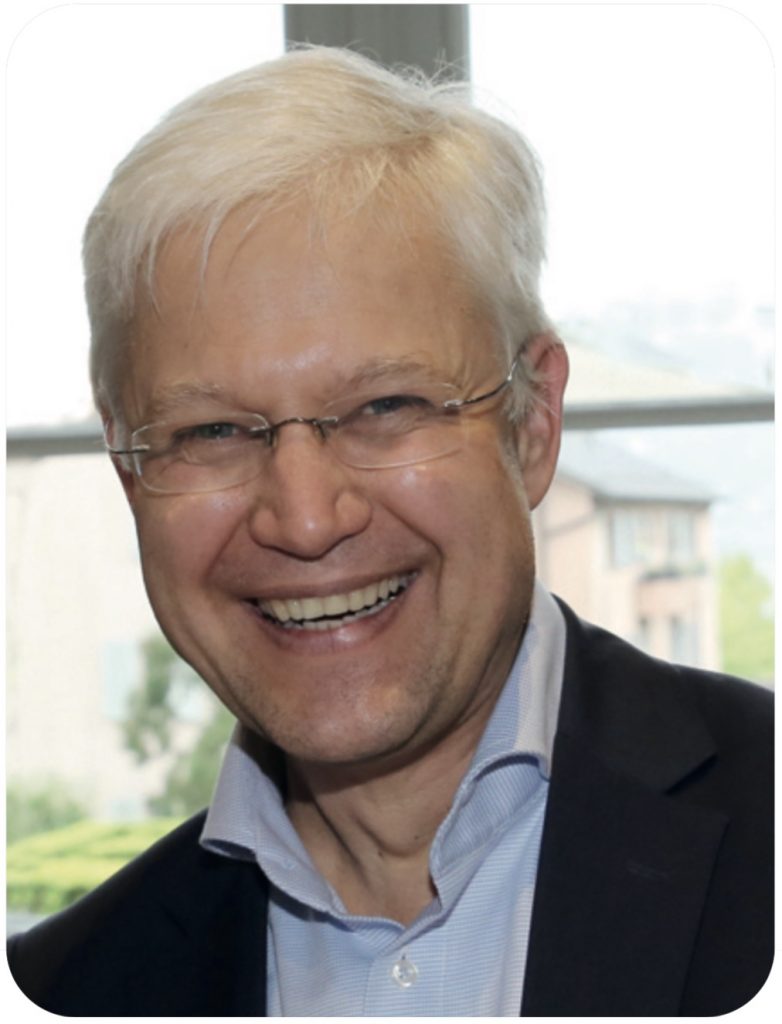- Get directions
- Leave a review
- Claim listing
- Bookmark
- Share
- Report
- prev
- next
- Tuesday, April 21, 2020 @ 10:00 am
Today IBM is best known for its work in the areas of artificial intelligence, blockchain and other leading software, services and technology products. But as far back as 1911 it was developing the first electronic patients’ records for the US military. Axel Nemetz, Head of IBM Life Sciences Switzerland, talks to Sirpa Tsimal, Director Investment Promotion with Switzerland Global Enterprise about his company’s role in life-sciences and healthcare and why Switzerland is the perfect place to be.

Axel Nemetz
Head of IBM Life Sciences Switzerland

Sirpa Tsimal
Director Investment Promotion Switzerland Global Enterprise
Tsimal: IBM is a long-time and prominent foreign investor in Switzerland. What makes Switzerland a good location for establishing a research center?
Nemetz: IBM’s Swiss affiliate was founded in 1927 and our Research Lab was established in 1956 in the Zurich area. Switzerland’s stable business environment, high level of education, global attraction for talent as well as its central location in Europe made it the first choice for a research lab outside the US.
Today IBM has 19 research locations around the world, but no other IBM lab gave rise to so many Nobel Prize winners as our Rueschlikon facility. Georg Bednorz, Gerd Binnig, Karl Alexander Müller and Heinrich Rohrer received the Nobel Prize for their work with IBM on the scanning tunnel microscope that can provide images down to individual atoms and for high temperature superconductivity which has the potential of a more careful use of energy. Switzerland’s strong infrastructure and multiple other benefits certainly helped to accomplish these achievements.
Tsimal: What value does Switzerland add to IBM as a location for emerging tech?
Nemetz: Besides having brought forward 4 Nobel laureates, our Rueschlikon lab also played host to the global coordination role for our research activities in security, blockchain, Internet of
Things. And it has close collaborations with renowned universities such as ETH and EPFL.
Switzerland is in particular interesting to us since it allows us close collaborations with corporate headquarters not only of leading global bio-pharma but also with leading global banking, insurance, technology assembly and nutrition companies. This is an interesting playground to jointly develop new technologies, hand-in-hand with our clients and in close collaboration with academia.
Tsimal: What trends do you see in Switzerland when it comes to AI and life sciences?
Nemetz: Switzerland’s legislation and commonsense-driven admin processes allow for the swift setting-up of pilots using new technologies. Take Medgate App, a “Doctor on an app” providing “teleconsultation” services. Medgate was developed here in Switzerland and is now a leading provider of digitally enabled remote health services with an established global reputation.
The local proximity to innovators like Medgate allows us to develop new technologies faster. Medgate and IBM jointly developed an augmented intelligence powered algorithm to remotely identify medically critical situations.
Looking at the macro picture, the biggest trend we observe in life sciences and healthcare in Switzerland is working to make high quality healthcare more affordable. This is a global trend that often embraces the benefits of new technologies like AI, blockchain and robotics; and that is no different from what we see in other countries. We believe that is one of the key drivers for change and potentially technology-enabled disruptions in the healthcare space.
Tsimal: Large tech companies like IBM, or Alphabet, Apple, Samsung, and Amazon. are getting into the healthcare space, while traditional pharma like Novartis and Roche are acquiring tech capabilities. Industry lines are blurring in the digital age. Do you see yourself as a healthcare disruptor?
Nemetz: We see ourselves as an enabler. Of course, sometimes the deployment of our technology can give rise to disruptions. However, since IBM focuses on B2B relations the level of disruption is mainly driven by our clients. Moreover, true disruptions are often a result of cross-stakeholder collaborations.
In the healthcare and life sciences field we currently only see initial models on the scale of these cross-stakeholder collaborations which are often initiated by payers. For example, the electronic medical record portal of “Techniker Krankenkasse (TK)” in Germany. TK initiated this model to allow patients to have faster access to their medical records in the case of a medical emergency or when visiting new healthcare providers.
TK’s approach was quickly adopted by patients and today, one year after its initiation, it already includes many providers who automatically upload their data to this portal. Stories like this can become a trigger point for true disruption in the healthcare industry.
Tsimal: Can you tell us about some of IBM’s current projects and use cases in biotech?
Nemetz: We are working, alone or in association with partners, e.g., on price modeling, companion diagnostics, clinical protocol design and trial-matching, to name a few.
Recruitment challenges and protocol amendments can lead to study delays and failures. These can often be traced back to the study design. IBM Study Advance can help overcome these problems. It’s built to optimize the protocol development process by providing both the power of data insights to make informed decisions and a collaboration platform to improve efficiency (https://www.ibm.com/products/study-advance).
Clinical trial-matching can shorten long drug development times. We have also developed a tool which streamlines clinicians search to identify a list of clinical trials for an eligible patient (https://www.ibm.com/downloads/cas/B5JGXRNK and https://www.ibm.com/us-en/marketplace/clinical-trial-matching-oncology).
On pricing, we have developed smart algorithms that allow pharma and biotech companies to model the impact of new product launches or loss of exclusivity.
Last but not least I would like to mention companion diagnostics. For example, in the area of diabetes we are working closely with pharma, biotech and diagnostics companies to better predict the impact of insulin dosage on the patient’s blood sugar levels in order to reduce medium term complications and improve the quality of life for patients.

Tsimal: In AI healthcare applications, what has IBM decided to focus on and why?
Nemetz: The healthcare environment is complex, not only because of the complexity of diseases and treatments but also because of the need for well-orchestrated coordination between the many stakeholders in a highly regulated environment.
If we divide AI into three phases - narrow AI, broad AI, and revolutionary - we are currently in the narrow AI phase. The implication is that we are focusing on the most promising areas where only few stakeholders are involved.
Examples would be our medical imaging collaboration with France-based Guerbet, that has its Swiss affiliate in Zurich, to support liver cancer diagnostics and care utilizing MRI and CT imaging. Another example is our collaboration with US-based Medtronic, that has its European headquarters in Vaud, to make living with diabetes a little easier with the power of our cognitive computing tools.
Finally, we are also working on ethics in AI to address topics like accountability, value alignment, ‘explainability’, fairness and user data rights.
Tsimal: Let’s talk about the IBM Watson health platform: Where do you see the future of this business and is IBM planning to develop other AI-powered systems for the other ‘omics’ such as proteomics, metabolomics, and transcriptomics?
Nemetz: Indeed, we are collaborating with the Geneva university hospitals that are using our IBM Watson for Genomics® solution to help them deliver personalized oncology care. In this context, I would like to mention a challenge we still see; namely the not yet sufficiently automated exchange of, sometimes anonymized or ‘pseudonymized’, data across providers and with payers or patients.
This is a key challenge we are trying to address with our Open Health Platform which allows different stakeholders across the industry to store, exchange and work with data in a regulated and secure environment. We see this is as another required step before moving from narrow or broad AI to revolutionary AI in the healthcare space.
Tsimal: Based on the IBM experience, how advanced is the use of Real World Data (RWD) in medicine, and what is IBM’s role in working with RWD?
Nemetz: This is a field of great demand. Pharma and biotech companies are highly interested to better understand patient pathways which can lead to innovations based on RWD. Other examples involve the use of clinical trial data with RWD data to accelerate decisions. As an example I would like to point to a joint paper by Roche and IBM published in Nature Medicine (Vol 25, January 2019, 57-59) last year. This paper looks into predicting the early risk of chronic kidney disease in patients with diabetes using real-world data.
“Switzerland is particularly interesting to IBM since it allows us close collaborations with corporate headquarters not only of leading global bio-pharma but also with leading global banking, insurance, technology and nutrition companies. This is an interesting playground to jointly develop new technologies, hand-in-hand with our clients and in close collaboration with academia.”
Axel Nemetz, Head of IBM Life Sciences Switzerland in an interview with Sirpa Tsimal, SGE
